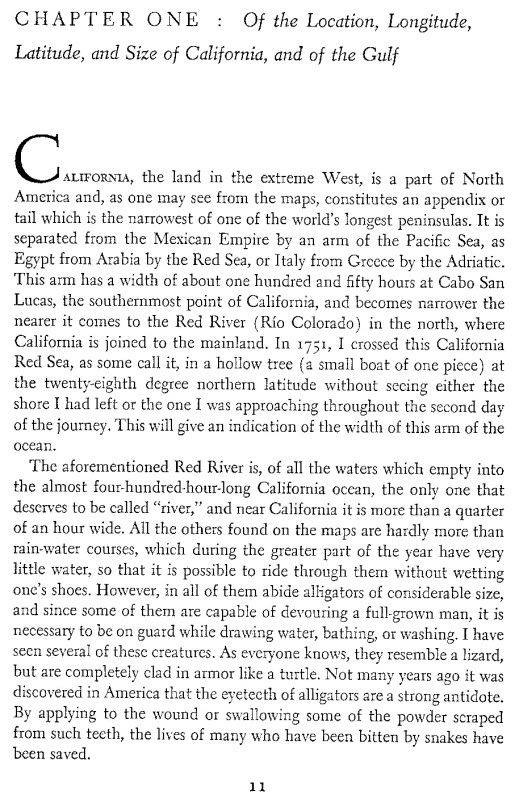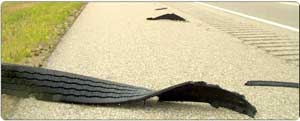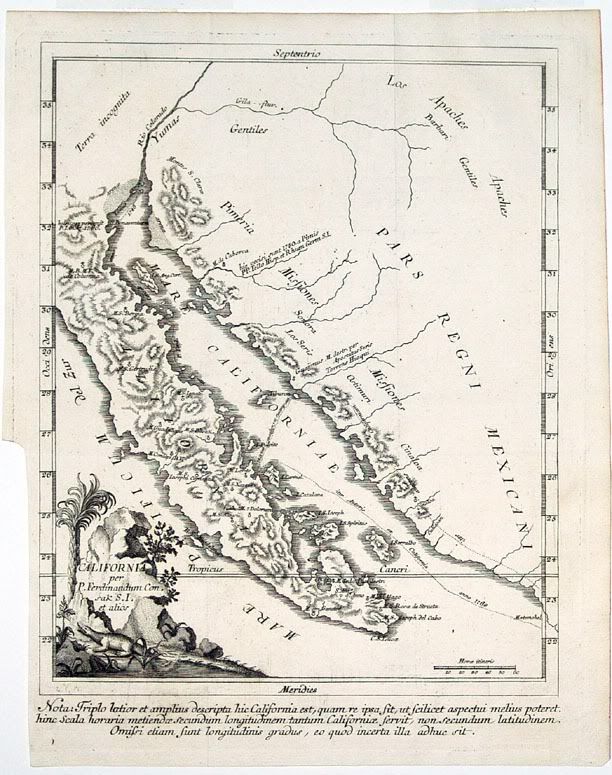| Pages:
1
2
3 |
Mexitron
Ultra Nomad
    
Posts: 3397
Registered: 9-21-2003
Location: Fort Worth, Texas
Member Is Offline
Mood: Happy!
|
|
Alligators
Was reading Baegert's "Observations in Lower California" (1772) and it was mentioned that alligators once roamed the waters of Baja...that was news to
me, but certainly makes sense in the warmer southern waters. Anyone have any more info on this?
|
|
|
DENNIS
Platinum Nomad
       
Posts: 29510
Registered: 9-2-2006
Location: Punta Banda
Member Is Offline
|
|
| Quote: | Originally posted by Mexitron
Was reading Baegert's "Observations in Lower California" (1772) and it was mentioned that alligators once roamed the waters of Baja...that was news to
me, but certainly makes sense in the warmer southern waters. Anyone have any more info on this? |
I've never seen them here, but I have seen them up close in San Blas on the mainland.
|
|
|
David K
Honored Nomad
        
Posts: 65218
Registered: 8-30-2002
Location: San Diego County
Member Is Offline
Mood: Have Baja Fever
|
|
A famous exaggeration by a missionary... The Second Harvest was another! 

[Edited on 12-4-2010 by David K]
|
|
|
Paulina
Ultra Nomad
    
Posts: 3810
Registered: 8-31-2002
Location: BCN
Member Is Offline
|
|
We find ourselves swerving to avoid running over Alligators on Hwy 1 all the time.

P<*)))>{

\"Well behaved women rarely make history.\" Laurel Thatcher Ulrich
|
|
|
Barry A.
Select Nomad
      
Posts: 10007
Registered: 11-30-2003
Location: Redding, Northern CA
Member Is Offline
Mood: optimistic
|
|
Well, if there is even the remotest possibility that gators or crocks existed in the SOC and the Baja rivers, then certainly we should reintroduce
them at once. After all, wolf and Grizz reintroduction into the USA, especially in CA, is high on some folks list of priorities.
By the way, bears in peoples backyards in CA are shot all the time, but CA F&G just does not know about it, for obvious reasons.
People first, then dangerous critters, is my motto---never the reverse.
Barry
(edited for spelling errors----whew, caught most of them)
[Edited on 12-4-2010 by Barry A.]
|
|
|
BajaBruno
Super Nomad
   
Posts: 1035
Registered: 9-6-2006
Location: Back in CA
Member Is Offline
Mood: Happy
|
|
I'm sorry to hijack this thread, but what is an "hour" as a unit of distance?
Christopher Bruno, Elk Grove, CA.
|
|
|
stevelaubly
Junior Nomad

Posts: 82
Registered: 3-29-2010
Location: Fresno & Costa Rica
Member Is Offline
|
|
| Quote: | Originally posted by BajaBruno
I'm sorry to hijack this thread, but what is an "hour" as a unit of distance? |
For people whose odometers don't work.
Similar to saying Santa Ana is about "2 six-packs" from San Diego 
|
|
|
BooJumMan
Senior Nomad
  
Posts: 915
Registered: 8-11-2007
Location: San Diego
Member Is Offline
|
|
| Quote: | Originally posted by BajaBruno
I'm sorry to hijack this thread, but what is an "hour" as a unit of distance? |
Lol, I was going to ask the same thing. I would love to know.
Hour walking? Hour sailing? Hour is a unit of time not distance says Engineering self... 
|
|
|
BajaBruno
Super Nomad
   
Posts: 1035
Registered: 9-6-2006
Location: Back in CA
Member Is Offline
Mood: Happy
|
|
I suppose stevelaubly is probably correct, but BooJumMan has legitimate questions. Certainly an "hour" in a dug-out canoe is not the same as an hour
in a proper sailing ship, and neither of which are an hour equivalent of walking.
These are the times when I wish I had an Oxford English Dictionary. The 1913 Webster is no help.
However, without running this into the ground, and comparing the "hours" to actual distances, it is clear that the good missionary was way off in his
calculations, but an hour in his distance must be close to a mile in ours.
Christopher Bruno, Elk Grove, CA.
|
|
|
David K
Honored Nomad
        
Posts: 65218
Registered: 8-30-2002
Location: San Diego County
Member Is Offline
Mood: Have Baja Fever
|
|
He is talking about the Colorado River (at the delta) being a "quarter of an hour wide"... we now use the term 'degree'... as in degrees, minutes,
seconds (on a map). A 'quarter of an hour' is 15 minutes or pretty close to 17 statute miles. A minute being a nautical mile.
More from the Internet:
Degree length
The length of an arcdegree of north-south latitude difference, , is about 60 nautical miles, 111 kilometres or 69 statute miles at any latitude; more
exactly, a degree of latitude at the pole covers about 1 percent more distance than a degree at the equator . The length of an arcdegree of east-west
longitude difference, roughly , is about the same at the Equator as the north-south, reducing to zero at the poles.
[Edited on 12-4-2010 by David K]
|
|
|
Mexitron
Ultra Nomad
    
Posts: 3397
Registered: 9-21-2003
Location: Fort Worth, Texas
Member Is Offline
Mood: Happy!
|
|
Are you sure that's an exaggeration David or a guess? Like Dennis mentioned---they're right across on the mainland, doesn't seem farfetched that they
would have lived on the SOC...probably though, since he did travel over the mainland to get to Baja he may have gotten mixed up in his locales...he
didn't sit down to write the book until after he returned to Germany.....
|
|
|
David K
Honored Nomad
        
Posts: 65218
Registered: 8-30-2002
Location: San Diego County
Member Is Offline
Mood: Have Baja Fever
|
|
| Quote: | Originally posted by Mexitron
Are you sure that's an exaggeration David or a guess? Like Dennis mentioned---they're right across on the mainland, doesn't seem farfetched that they
would have lived on the SOC...probably though, since he did travel over the mainland to get to Baja he may have gotten mixed up in his locales...he
didn't sit down to write the book until after he returned to Germany..... |
I don't know for certain Steve... but surely there would be more records or evidence of alligators... I wasn't aware of any on the Pacific Coast of
Mexico...?
One thing is true, none of us were alive back then so we can only trust what is written or what we see evidence of.
Thanks for posting... Fun to resarch this sort of thing... I will keep looking to see if ANYBODY else has recorded alligators in Baja...
|
|
|
DENNIS
Platinum Nomad
       
Posts: 29510
Registered: 9-2-2006
Location: Punta Banda
Member Is Offline
|
|
Well, I'm not confused. Around 1965 I sat in Torino's Bar in San Blas one afternoon having a cold one while leaning on a small wall around a watery
tropical garden setting. The place was dark and it was hard to see. The only other patron who was sitting at the bar told me I shouldn't be hanging
my arm over the wall. I looked closer to where he refered and saw a four foot gator about two feet from my arm.
Turns out, in all of the waterways that go inland, gators can/could be found in abundance and I saw this myself at the end of a river ride. There was
a concrete bathtub type thing with around 50 small gators in it. For what...I don't know.
Since I've heard they also taste like chicken, they're probably gone too.
|
|
|
Cypress
Elite Nomad
     
Posts: 7641
Registered: 3-12-2006
Location: on the bayou
Member Is Offline
Mood: undecided
|
|
They do taste kind of like chicken, different texture. Can be found in some restaurants down in Louisiana. Make various dishes out of 'em.
|
|
|
Taco de Baja
Super Nomad
   
Posts: 1913
Registered: 4-14-2004
Location: Behind the Orange Curtain, CA
Member Is Offline
Mood: Dreamin' of Baja
|
|
I don't think the SOC has ever had alligators. I think Baegert was spinning tall tales. And even put an alligator on his map.

| Quote: |
Rare map of Baja California and northern Mexico based on the explorations of the Jesuit Ferdinand Consag, which confirmed Kino’s reports of the
non-insularity of California. The map appeared in Jacob Baegert’s Observations in Lower California, in which he reports: “After Father Ferdinand
Konschak (Consag), a Jesuit from Hungary, investigated and explored the entire east coast of California as far as the Colorado River (which he
followed upstream for several hours in 1746), it can no longer be doubted that California is a peninsula, bounded by the sea on three sides only,
rather than completely surrounded as was once believed.” Kino’s journeys of 1684-5 had been undertaken by land and were not considered to be
definitive proof that California was not an island.
Baegert’s map includes details of the Jesuit missions of Baja California and Northern Mexico. He also adds the path of his own journey to California
from Mexico in 1751 as well as of his departure upon the expulsion of the Jesuits from California in 1768. Baegert’s notes on the map tend to support
his view of California as a wasteland full of dangerous savages: “Here Fathers Tello of Spain and Ruhen of Germany were killed in 1750 by Pimi
(Indians);” ”Mission of Guaymas destroyed by apostate Seri (Indians);” “Los Apaches: Heathen Savages.” The map is attractively engraved with a
cartouche decorated with craggy rocks, sparse vegetation, a palm tree, and an alligator.
|
Link
Truth generally lies in the coordination of antagonistic opinions
-Herbert Spencer
|
|
|
toneart
Ultra Nomad
    
Posts: 4901
Registered: 7-23-2006
Member Is Offline
Mood: Skeptical
|
|
| Quote: | Originally posted by BajaBruno
I suppose stevelaubly is probably correct, but BooJumMan has legitimate questions. Certainly an "hour" in a dug-out canoe is not the same as an hour
in a proper sailing ship, and neither of which are an hour equivalent of walking.
These are the times when I wish I had an Oxford English Dictionary. The 1913 Webster is no help.
However, without running this into the ground, and comparing the "hours" to actual distances, it is clear that the good missionary was way off in his
calculations, but an hour in his distance must be close to a mile in ours. |
I often refer to hours in reference to distance. I think it is valid if you agree upon the mode of transportation. I am more interested in
knowing how long it will take to reach a destination. Miles or kilometers are an abstract reference that are only important to engineers and
cartographers.   
|
|
|
David K
Honored Nomad
        
Posts: 65218
Registered: 8-30-2002
Location: San Diego County
Member Is Offline
Mood: Have Baja Fever
|
|
Alligators in Western Mexico? No, but...

THE DIFFERENCE BETWEEN ALLIGATORS AND CROCODILES
The two are often confused, but visually crocs and alligators are quite different. Alligators have a very broad, wide snout, and crocodiles have a
narrower snout and jaw. Also crocodiles often have a lower tooth that juts out noticeably, while an alligator's fourth tooth is hidden.
WHERE THEY LIVE
Crocodilians are a cold-blooded species, and require an average temperature of approximately 80 degrees Fahrenheit to survive. This being the case,
they are found on warmer continents that have swampy or humid conditions for at least part of the season.
The American alligator lives almost exclusively in the lower southeast regions of North America, from the Carolinas to Texas.
The caiman, a smaller species of crocodiles, populate a large section of southern Mexico, Central and South America.
The Chinese alligator lives in the lower Yangtze valley in China.
The American crocodile is scattered throughout the Everglades and Florida Keys, and in Mexico and Central America.
The African Nile crocodile is one of the most notorious, often growing as large as 16 to 20 feet in length.
Southeast Asia has the Indo-Pacific crocodile, which lives in Indonesia, to the Philippines, and Australia.
===================================================
The American crocodile (Crocodylus acutus) is a species of crocodilian found in the Neotropics.
It is the most widespread of the four extant species of crocodiles from the Americas.
Populations occur from the Atlantic and Pacific coasts of southern Mexico to South America as far as Peru and Venezuela. It also lives within many
river systems on Cuba, Jamaica, and Hispaniola. Within the United States the American crocodile is only found within the southern half of Florida. In
Florida, there is an estimated population of about 2000. Despite its proximity to Hispaniola, the American crocodile is not found in Puerto Rico.
The habitat of the American crocodile consists largely of coastal areas. The American crocodile is larger than some other crocodile species, with some
males reaching lengths of 6.1 metres (20 ft) in Central and South America.

Looks like we got crocs in the Sea of Cortez... on the mainland side!
|
|
|
BajaBruno
Super Nomad
   
Posts: 1035
Registered: 9-6-2006
Location: Back in CA
Member Is Offline
Mood: Happy
|
|
David K., I have to argue with the idea that an hour is a degree, even though it makes perfect sense and both have sixty minutes. If that were true,
then his estimate of the width of the SOC from Cabo (150 hours, or 9,000 nautical miles) is so greatly exaggerated that it seems implausible that he
could have believed it true.
Similarly, he writes that the Baja peninsula is 400 hours long, which would translate to 24,000 n. miles if an hour were a degree. He must have known
that could not possibly be correct.
Am I missing something here?
As for the lizards, the distribution of Crocodylus acutus is reported to extend fairly far up of the Sea of Cortez. Perhaps in earlier times it
extended even further north. See: http://www.flmnh.ufl.edu/cnhc/cst_cacu_dh_map.htm
Christopher Bruno, Elk Grove, CA.
|
|
|
DENNIS
Platinum Nomad
       
Posts: 29510
Registered: 9-2-2006
Location: Punta Banda
Member Is Offline
|
|
"Looks like we got crocs in the Sea of Cortez... on the mainland side!"
----------------------------
So...If you slide Baja over to the mainland where it once was, they would be in this area as well. Sí??
|
|
|
Barry A.
Select Nomad
      
Posts: 10007
Registered: 11-30-2003
Location: Redding, Northern CA
Member Is Offline
Mood: optimistic
|
|
| Quote: | Originally posted by DENNIS
"Looks like we got crocs in the Sea of Cortez... on the mainland side!"
----------------------------
So...If you slide Baja over to the mainland where it once was, they would be in this area as well. Sí?? |
I doubt that they (the crocs) would survive the "big squeeze", Dennis.
Barry
|
|
|
| Pages:
1
2
3 |

